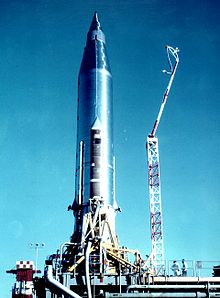 Atlas B (10B) before the launch of SCORE (USAF) | |
| Function | Prototype ICBM Expendable launch system |
|---|---|
| Manufacturer | Convair |
| Country of origin | United States |
| Launch history | |
| Status | Retired |
| Launch sites | LC-11, LC-13 & LC-14, CCAFS |
| Total launches | 10 |
| Success(es) | 6 |
| Failure(s) | 4 |
| First flight | 19 July 1958 |
| Last flight | 4 February 1959 |
| Boosters | |
| No. boosters | 1 |
| Powered by | 2 XLR-89-5 |
| Total thrust | 341,130 lbf (1,517.4 kN) |
| Specific impulse | 282 s |
| Burn time | 135 s |
| Propellant | RP-1/LOX |
| First stage | |
| Powered by | 1 XLR-105-5 |
| Maximum thrust | 86,844 lbf (386.30 kN) |
| Specific impulse | 309 s |
| Burn time | 240 s |
| Propellant | RP-1/LOX |
The Convair SM-65B Atlas, or Atlas B, also designated X-12[1] was a prototype of the Atlas missile. First flown on 19 July 1958, the Atlas B was the first version of the Atlas rocket to use the stage and a half design with an operational sustainer engine and jettisonable booster engine section. Unlike later Atlas models, the Atlas B used explosive bolts to jettison the booster section.
Ten flights were made. Nine of these were sub-orbital test flights of the Atlas as an Intercontinental Ballistic Missile, with five successful missions and four failures. The seventh flight, launched on 18 December 1958, was used to place the SCORE satellite into low Earth orbit, the first orbital launch conducted by an Atlas rocket.